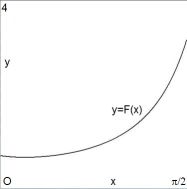
F(x) := ln(exp(2*x)+1)/(1+sin(2*x));
evalf(int(F(x),x=0..Pi/2),16);
1.830481056481415
As compared with the value in the comment by Iuʇǝƃɹɐʇoɹ : $1.830481056481482$ .
program numeric;Output:
function F(x : double) : double; begin F := ln(exp(2*x)+1)/(1+sin(2*x)); end;
function lower(N : integer) : double; var k : integer; x,dx,sum : double; begin sum := 0; dx := (Pi/2)/N; for k := 0 to N-1 do begin x := (Pi/2)*k/N+dx/2; { Midpoint rule } sum := sum + F(x)*dx; end; lower := sum; end;
function upper(N : integer) : double; var k : integer; x1,x2,dx,sum : double; begin sum := 0; dx := (Pi/2)/N; x2 := 0; for k := 1 to N do begin x1 := x2; x2 := (Pi/2)*k/N; { Trapezium rule } sum := sum + (F(x1)+F(x2))/2*dx; end; upper := sum; end;
begin Writeln(lower(1000000)); Writeln(upper(1000000)); end.
1.83048105648054E+0000 1.83048105648321E+0000It helps to make a little sketch of the function $F(x) = \ln(e^{2x}+1)/(1+\sin(2x))$ :

Due to this function behaviour, the Midpoint rule give a lower bound, while the Trapezium rule gives an upper bound for the integral. Thus we find with certainty that: $$ 1.830481056480 < \int_{0}^{\pi/2} \frac{\ln\left(e^{2x} + 1\right)}{1 + \sin2x}\mathrm dx < 1.830481056484 $$ The results with Mathematica and MAPLE are well within these bounds.